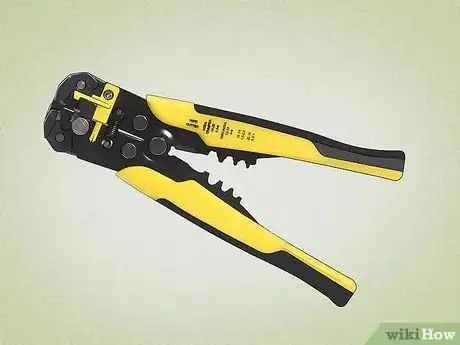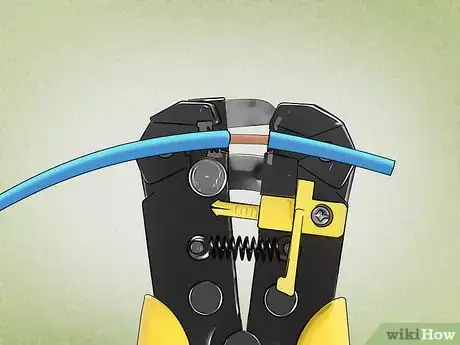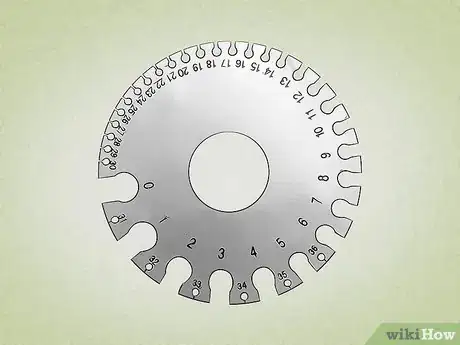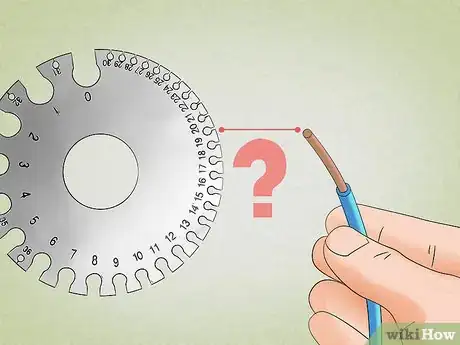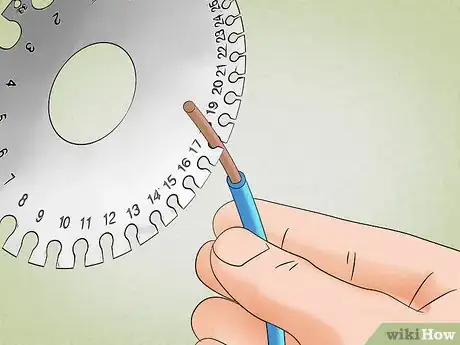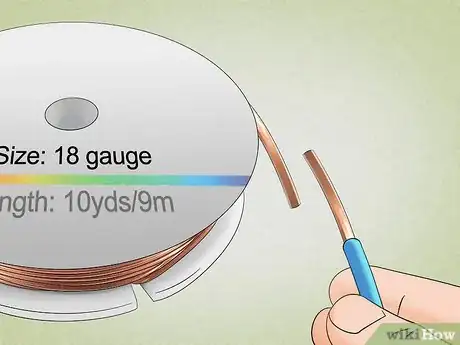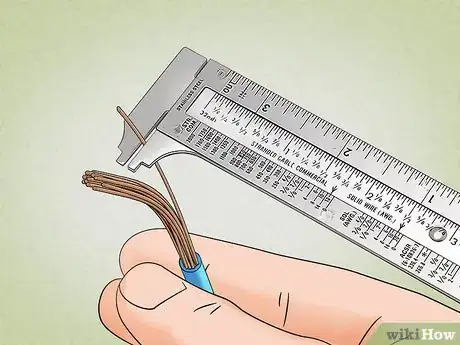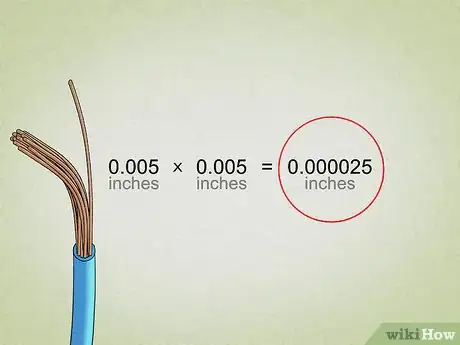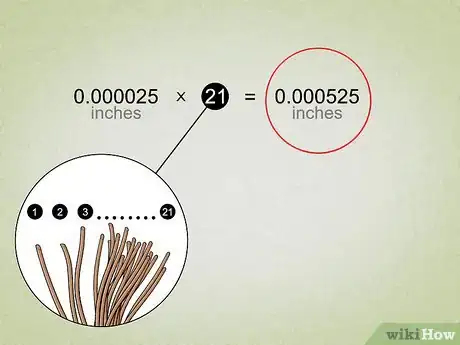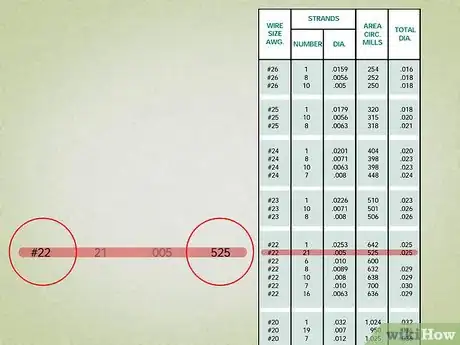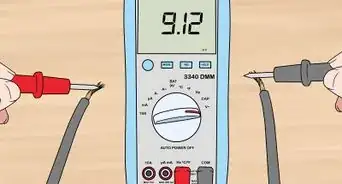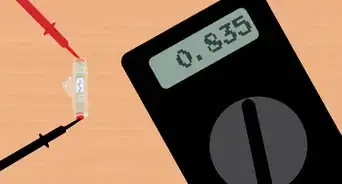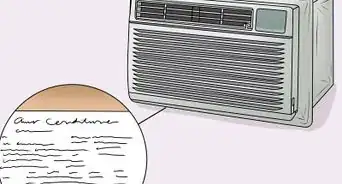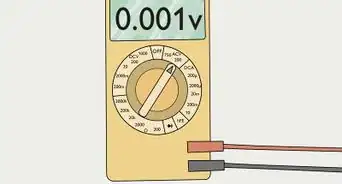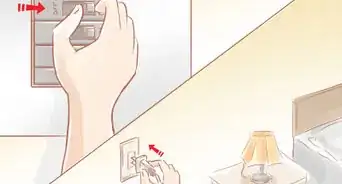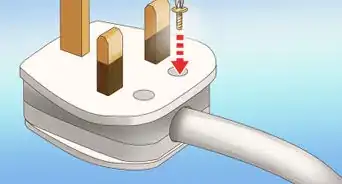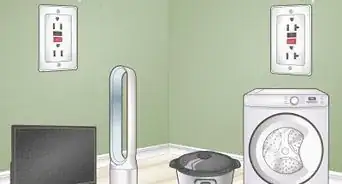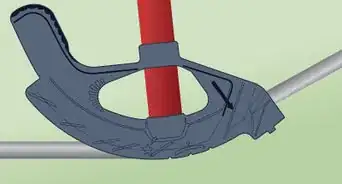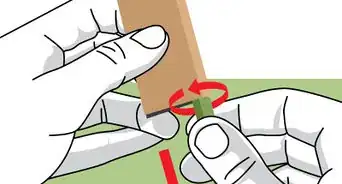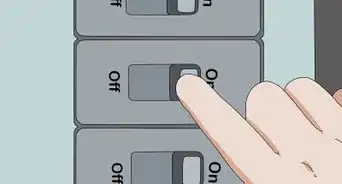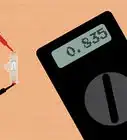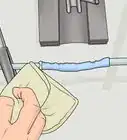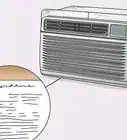This article was co-authored by Ricardo Mitchell. Ricardo Mitchell is the CEO of CN Coterie, a fully licensed and insured Lead EPA (Environmental Protection Agency) Certified construction company located in Manhattan, New York. CN Coterie specializes in full home renovation, electrical, plumbing, carpentry, cabinetry, furniture restoration, OATH/ECB (Office of Administrative Trials and Hearings/Environmental Control Board) violations removal, and DOB (Department of Buildings) violations removal. Ricardo has over 10 years of electrical and construction experience and his partners have over 30 years of relevant experience.
There are 7 references cited in this article, which can be found at the bottom of the page.
This article has been viewed 234,653 times.
The “gauge” of a piece of wire refers to its diameter. On the American Wire Gauge (AWG) scale, gauge sizes run from 0000 (also written 4/0) to nearly 60. The larger the diameter of the wire, the smaller its gauge number will be. You can measure the gauge on either round solid wire (an individual wire with no insulation) or stranded wire (a number of strands wrapped together). To measure the gauge of a piece of wire, you’ll need to strip any insulation (the plastic coating which surrounds the wire), and then use a wire-gauge tool to measure the size.
Steps
Stripping Insulation
-
1Purchase a wire-stripping tool. As it’s impossible to gauge a wire with the insulation on, you’ll need to remove this thin plastic protective coating before measuring the wire gauge. The wire-stripping tool is specifically designed for this task: it looks a little like a pair of pliers. The tool has a small hole near its tip, which is lined with a sharp blade to cut through and remove plastic insulation.[1]
- You should be able to find a wire-stripping tool at any local hardware store.
-
2Place two inches of wire through the stripping tool. Your insulated wire should fit tightly into the small, sharp hole in the wire-stripping tool. Stripping the insulation off of about 2 inches (5 cm) of wire will give you plenty to work with when measuring gauge.[2]
- Rather than providing a one-size-fits-all wire-gauging hole, many pairs of wire strippers are themselves gauged. A gauged stripper will have about 10 holes of varying gauge sizes running up and down the interior of the tool’s ‘blades.’[3]
- This means that you’ll need to approximate the gauge of the wire (even if you don’t know it beforehand) to remove the insulation from the wire.
Advertisement -
3Clamp down and pull off the insulation. Once the wire has been inserted into the stripper tool’s hole, squeeze the handles together. Pull the stripper tool away from the full piece of wire to slice through the plastic insulation and slide it off the end of the wire.[4]
- At this point, you should have 2 inches (5 cm) of exposed wiring, of which you can measure the gauge.
-
4Contact the wire manufacturer for the diameter of insulated wire. If it’s important to your electrical project that you know the exact diameter of insulated wire, you’ll need to get in touch with the manufacturer directly. If you’re unsure which company manufactured the wire, take it to your local hardware store. They may be able to identify the company, and if not, they can measure the wire for you anyway.[5]
- Although gauge sizes are universal, different companies put different amounts of plastic insulation around their wires.
- The diameter measurement will not be an actual gauge size, since only uninsulated solid wires are gauged.
Gauging Round Solid Wire
-
1Purchase a wire gauging tool. A wire gauging tool is a piece of metal (typically circular or rectangular) which is studded with dozens of holes around its perimeter. Each hole is labeled with—and corresponds to—a different gauge size.[6]
- Make sure that the gauge tool specifies which measurement system it corresponds with. If you’re located in North America, your tool will probably measure on the AWG scale.
- You can purchase a wire gauging tool at your local hardware store or home-supply store).
-
2Estimate the gauge size of the wire. Begin by eyeballing the approximate size of the wire and see which gauge holes are roughly the same size. This will save you time that you’d otherwise spend on trying to fit the wire into many too-large or too-small gauge grooves.[7]
-
3Slide your wire into the gauge groove and see where it fits. Place the wire into each groove until you find the best fit. Your wire will correspond with the size of the smallest gauge groove that it slides into. The fit should be snug but not too tight.[8]
- Note that each of the grooves will have a slightly larger hole located next to it. These holes are not used to measure gauge size. They’re simply on the tool to allow you to easily remove the wire from the grooves.
-
4Compare the wire against another wire whose gauge is known. If you do not have a wire gauge tool, you can still find a wire’s gauge by measuring it against another wire of known gauge size. For example, if you have a small-diameter section of wire, hold it next to wires of known gauge (e.g. 20, 21, and 22) to see which your segment matches.
- If you don’t have any other wires whose gauge you know, take your wire strand to a local hardware store. They’ll likely have enough gauged wire in their inventory that they can pull out various sizes of wire for you to compare your strand with.
Gauging Stranded Wire
-
1Measure the diameter of a single wire. Stranded wire consists of multiple thin wire filaments that have been twisted together to form a single composite “wire.” To calculate the gauge of stranded wire, you’ll need to find the diameter of a single wire strand in either millimeters or inches.[9]
- If the wire is of a very large gauge (very small diameter) and can’t be measure with a ruler, use a wire and conduit measuring device. This tool can also be purchased at any hardware store.
-
2Multiply the wire’s diameter by itself. To calculate the gauge of stranded wire, you’ll need to double the diameter. So, if you’ve measured a wire’s diameter to be 0.005 inches (0.127 mm), multiply this value by itself. The result will be 0.000025 in (0.000635 mm).[10]
-
3Multiply the result by the number of strands in the wire. Depending on the size of the wire, it could have any number of individual, entwined strands. Count the individual strands, and multiply the result of the squared wire diameter by the number of strands. In this example, if the wire has 21 strands, multiply 0.000025 in (0.000635 mm) by 21. The result will be 0.000525 in (0.013335 mm).[11]
- This calculation will give you the Circular Mils (CMA) value for the stranded wire. CMA is another commonly used wire-gauge scale which calculates the circular area of wires.
- As a general rule, larger-gauge wire (smaller diameter) contains fewer strands. Large-gauge wires may contain as few as 7 or 8 strands, while small-gauge (large diameter) wires may contain as many as 20, 40, or even 100 strands.
-
4Find the wire’s corresponding AWG value. Once you’ve found the Circular Mils value of stranded wire, you’ll need to consult an online table in order to find the corresponding AWG value. Alternately, your local hardware store may have a physical copy of gauge-comparison table.[12]
- For example, if you measure the diameter of a wire strand as 0.005 inches (0.127 mm) and the stranded wire has 21 strands, this corresponds to a CMA of 525 and to an AWG of 22.
Expert Q&A
Did you know you can get expert answers for this article?
Unlock expert answers by supporting wikiHow
-
QuestionHow do I gauge stranded wire?
 Ricardo MitchellRicardo Mitchell is the CEO of CN Coterie, a fully licensed and insured Lead EPA (Environmental Protection Agency) Certified construction company located in Manhattan, New York. CN Coterie specializes in full home renovation, electrical, plumbing, carpentry, cabinetry, furniture restoration, OATH/ECB (Office of Administrative Trials and Hearings/Environmental Control Board) violations removal, and DOB (Department of Buildings) violations removal. Ricardo has over 10 years of electrical and construction experience and his partners have over 30 years of relevant experience.
Ricardo MitchellRicardo Mitchell is the CEO of CN Coterie, a fully licensed and insured Lead EPA (Environmental Protection Agency) Certified construction company located in Manhattan, New York. CN Coterie specializes in full home renovation, electrical, plumbing, carpentry, cabinetry, furniture restoration, OATH/ECB (Office of Administrative Trials and Hearings/Environmental Control Board) violations removal, and DOB (Department of Buildings) violations removal. Ricardo has over 10 years of electrical and construction experience and his partners have over 30 years of relevant experience.
Electrician & Construction Professional, CN Coterie
Warnings
- Whenever you’re working with electrical wires, make sure that the wire is not plugged in and that no electrical charge is running through it.⧼thumbs_response⧽
Things You'll Need
- wire
- wire-stripping tool
- wire-gauging tool
- a range of gauged wires (optional)
- wire and conduit measuring device
- calculator (optional)
References
- ↑ https://www.sciencebuddies.org/science-fair-projects/references/wire-stripping-tutorial#stripping_hookup_wire
- ↑ https://www.sciencebuddies.org/science-fair-projects/references/wire-stripping-tutorial#stripping_hookup_wire
- ↑ Ricardo Mitchell. Electrician & Construction Professional, CN Coterie. Expert Interview. 6 May 2020.
- ↑ https://www.sciencebuddies.org/science-fair-projects/references/wire-stripping-tutorial#stripping_hookup_wire
- ↑ http://www.dave-cushman.net/elect/wiregauge.html
- ↑ http://www.dave-cushman.net/elect/wiregauge.html
- ↑ https://www.wigjig.com/jewelry-techniques/tools/1192-wire-gauge-tool
- ↑ https://www.wigjig.com/jewelry-techniques/tools/1192-wire-gauge-tool
- ↑ Ricardo Mitchell. Electrician & Construction Professional, CN Coterie. Expert Interview. 6 May 2020.
About This Article
To gauge wire, you’ll first need to strip the wire, then use a wire gauging tool to measure its diameter. Start by stripping the insulation with a wire stripping tool. Place 2 inches of wire through the tool, clamp it down, and pull off the insulation to expose the wires inside. Then, untangle and straighten the wires and use either a ruler or a wire and conduit measuring tool to measure the diameter of a single wire. Double the wire's diameter so you can calculate the gauge of a stranded wire. Then, multiply that number by the number of individual wire strands to find the Circular Mils value. Take that value and consult an online table or use a physical comparison table to find the coordinating American Wire Gauge scale value and gauge the wire. For tips about purchasing a wire gauging tool to gauge wire, keep reading!
